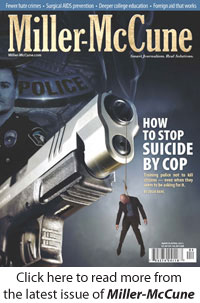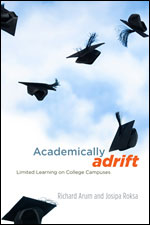Here’s the situation. You’re an assistant to the president at DynaTech, a firm that makes navigational equipment. Your boss is about to purchase a small SwiftAir 235 plane for company use when he hears there’s been an accident involving one of them. You have the pertinent newspaper clippings, magazine articles, federal accident reports, performance graphs, company e-mails and specs and photos of the plane.
Now, write a memo for your boss with your recommendation on the SwiftAir 235 purchase. Include your reasons for finding that the wing design on the plane is safe or not and your conclusions about what else might have contributed to the accident.
You have 90 minutes.
Whew. That’s a sample “performance task” from the three-hour Collegiate Learning Assessment, a national test used by more than 200 colleges and universities to measure whether their undergraduates are learning to think critically in real-world scenarios and communicate effectively in writing.
Given the average cost of an undergraduate college education today — $16,000 per year for tuition, room and board at public schools and $37,000 at private institutions — one could be excused for believing that college students must be learning how to think.
But according to a new book, Academically Adrift: Limited Learning On College Campuses, they’re frittering away their time at an astonishing rate. And the result, it shows, is that 45 percent of undergraduates in a survey of 29 colleges and universities nationwide showed no improvement in critical-thinking scores at the end of their sophomore year in 2007, compared to their scores as entering freshmen. At the end of their senior year, after four years of college instruction, 36 percent still had made no gains in critical thinking.
“Slacker” students are nothing new. But the picture from Academically Adrift is one of pervasive distraction in the halls of higher learning, of disengaged students and a faculty too busy with research to demand much of them.

“We found a set of conditions suggesting that something indeed is seriously amiss in U.S. higher education,” says Richard Arum, a co-author and a sociologist at New York University. “We found that gains in student performance are disturbingly low. Students and faculty and administrators share equally in the blame.
“It’s a serious social problem that threatens the foundation of our society, our economic competitiveness and our ability to govern ourselves democratically.”
Arum and co-author Josipa Roksa, a sociologist at the University of Virginia, found that undergrads study only 13 hours per week, on average, or less than two hours per day in a typical semester. That’s half as much as their peers studied in the early 1960s. Today’s college students spend more than 80 percent of their time, on average, on work, clubs, fraternities, sororities, sports, volunteering, watching TV, exercising, socializing, playing on their computers and sleeping.
Of more than 3,000 full-time undergraduates in the study, 50 percent took five or fewer classes over their entire four years of college in which they were required to write more than 20 pages per semester. Twenty percent took five or fewer classes requiring more than 40 pages of reading per week. They met with a professor outside of class only once a month, on average.
Of course, not all students or professors are neglecting academics: Arum and Roksa found a wide variation in scores among colleges and even wider variation among students at the same colleges. But in an era when elementary and secondary schools are being held strictly accountable for student learning, Arum says, the absence of accountability at the college level is glaring. It’s not that faculty doesn’t care, he says. It’s that the system rewards research, not teaching. “College presidents have to assume the responsibility to provide leadership for improving instruction and measuring learning,” Arum said. “They have trustees and regents that report to, and they should be held accountable. Let’s start there.”
Source: Academically Adrift: Limited Learning on College Campuses, 2011
Arum and Roksa’s findings, as reported in their book and an accompanying update, largely confirm the work of other scholars. In 2009, for example, Philip Babcock and Mindy Marks, two University of California economists, reported that full-time students in 1961 invested 40 hours per week attending classes and studying, compared to 27 hours per week for students in 2004.
“Study time fell for students from all demographic subgroups, within race, gender, ability, and family background, overall and within major, for students who worked in college and for those who did not, and the declines occurred at four-year colleges of every type, size, degree structure and level of diversity,” Babcock and Marks found.
But Arum and Roksa break new ground, too, delving into the past of individual students and following the same individuals through four years of college. To find out how and why they learn, the sociologists tracked their family backgrounds, high school characteristics, advanced placement courses, SAT and ACT scores, choice of college, choice of college major, college coursework, study habits and professors’ expectations.
High school preparation counts, their book shows, but the college experience counts just as much. Students who take multiple advanced placement classes in high school and have high SAT and ACT scores perform notably better on the test for critical thinking and complex reasoning, but so do students who enroll in highly selective colleges, pursue demanding majors, take rigorous courses and spend 15 or 20 hours per week studying alone. (The average college student spends eight hours per week studying alone, and more than a third of undergrads spend five or fewer hours per week studying alone, the authors found.)

Students’ majors matter, too. Those in traditional liberal arts fields such as social science, humanities, natural science and mathematics show much higher gains on the critical-thinking test than students in the less demanding “practical arts” – business, education, social work and communications.
Academically Adrift shows that the achievement gap between white and minority students persists at the end of four years of college, and, for African Americans, it widens. “This pattern suggests that higher education in general reproduces social inequality,” the authors say.
Finally, Academically Adrift debunks the view, promoted by some colleges, that group studying, working on campus and joining a fraternity or a sorority helps keep potential dropouts in college and therefore enhances learning. Unfortunately, the more time students spend in these activities, the worse they do on the tests for critical thinking. Overall, undergraduates are working at jobs 14 hours per week, on average — more time than they spend preparing for class.
“The simple act of staying enrolled does not ensure that students are learning much,” the authors conclude.
What are college students thinking? For a glimpse, Arum and Roksa cite from College Life Through the Eyes of Students, a 2009 book about the lives of 60 students during four years at an unnamed public university in the Midwest. Of the 60 undergraduates who were interviewed by Mary Grigsby, a sociologist at the University of Missouri, only four, or 7 percent, regarded academics as their top priority. Seventy percent viewed “social learning” as more important.
“Honestly, I feel like nothing I’ve learned in the classroom will help me do what I want to do in the end,” one coed says. “I think it’s the people I meet, the friends I make, that really matter. …”
“Like” Miller-McCune on Facebook.
Follow Miller-McCune on Twitter.
Add Miller-McCune.com news to your site.





